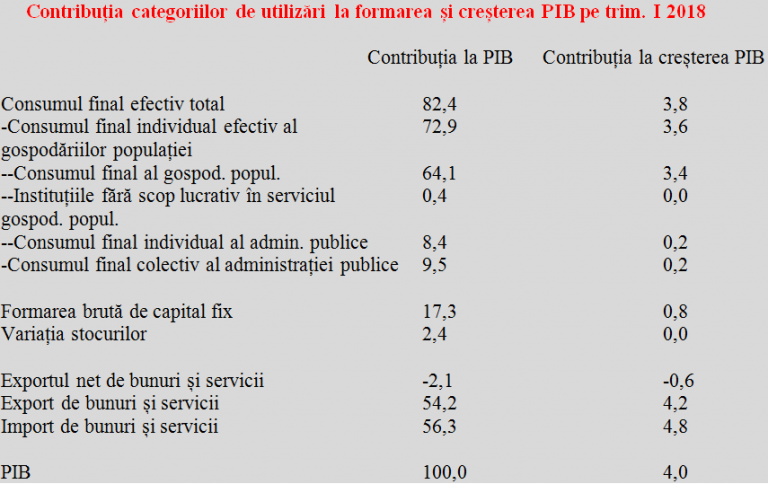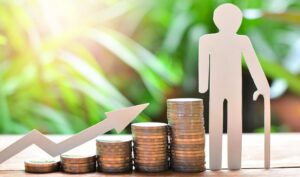 The National Institute of Statistics confirmed the last mid-month signal estimate and announced a 4.0% increase in the Gross Domestic Product for the first quarter of 2018, on gross series and a 4.2% increase on the seasonally adjusted series.
The National Institute of Statistics confirmed the last mid-month signal estimate and announced a 4.0% increase in the Gross Domestic Product for the first quarter of 2018, on gross series and a 4.2% increase on the seasonally adjusted series.
Compared to the previous quarter, it has been maintained in this technically called 1st provisional version, the value of 0%, which means an economic stagnation as compared to the previous quarter.
Basically, the results are mixed, the bottom-line effect of last year’s good results has been felt both in the 4% increase over the same period in 2017 and in the 0% level which, paradoxically, is less worrying than the first reporting.
The one that assumes we shall need a rate of 6.6% by the end of this year in order to obtain the 6.1% increase estimated by the National Commission for Strategy and Prognosis.
In nominal terms, the quarterly GDP was RON 176.7 billion, with the mention that this first quarter of the year has a weight of about 19% in the final result for the current year.
We remind that the Ministry of Finance works with reports where the 2018 GDP was estimated at about RON 930 billion, a level to which the public deficit of 2.97% of GDP would also be related.
Beyond the series of values showing the evolution of GDP, which maintained unchanged, the novelty of the INS announcement is the contribution of the resource categories to the economic growth.
According to the INS data, it is easy to see that „the lion’s share” came to the manufacturing sector (1.0%), while trade contributed only „0.8%”, which contradicts the thesis of a consumption-based growth.
But this happens given the fact that the 4% growth rate was much closer to potential GDP (namely in the context of maintaining macroeconomic balances) than last year when it had increased to a level now estimated at 6.9%. It should also be kept in mind that gross value added exceeded the 90% of GDP threshold and contributed 80% of the economy’s advance.
*
- Contributions of resources categories to GDP formation and growth in Q1 2018
- Sector
- Manufacturing
- Trade, transport, auto repairs, hotels, etc.
- Public administration, education, health, etc.
- Real estate transactions
- Construction
- Professional activities, support services, etc.
- IT&C
- Agriculture, forestry, fishery
- Financial intermediations, insurance
- Shows, household repairs, other services
- Gross VAT
- Net tax on products
- GDP
*
The share of public administration in the GDP formation rose to 15% in the context of consistent increases in salaries in the public sector and the contribution to GDP growth reached 0.3%, the same as the one marked by professional activities and support services (with the mention that, salary increases in the public sector are assimilated to an improved performance)
It should also be noted that the level of the economic growth to be communicated to Eurostat to ensure the international comparability is 4.2% as a result of adjusting gross data by the seasonality.
Otherwise, the growth rate compared to the previous quarter registered at the beginning of this year is the highest in the last six quarters and matched the level in the first quarter of 2016.
*
- Quarterly GDP evolution compared to the same quarter of the previous year
- Quarter
*
Household consumption had a 3.8 percentage point influence on the GDP growth, while net exports brought a minus of 0.6 percentage points, meaning an internal deficit in the capacity to cover the domestic demand, a trend in expansion as a result of the significant increase in the purchasing power (see table).
*
- Contribution of usage categories to GDP formation and growth in Q1 2018
- Contribution to GDP Contribution to GDP growth
- Total final effective consumption
- Household final effective individual consumption
- Household final consumption
- Non-profit-making institutions serving households
- Final individual consumption of public administration
- Final collective consumption of public administration
- Gross formation of fixed capital
- Stocks variation
- Net export of goods and services
- Export of goods and services
- Import of goods and services
- GDP
*
With a share of only 17.3% of the gross fixed capital formation on the use of GDP and a 0.8% influence on the economic growth, the prospects of bringing production and work productivity (which followed a downward trend in the first three months of the year) closer to the absorption capacity of the domestic market does not look too good.
That means higher investments are needed, especially in the public sector.












